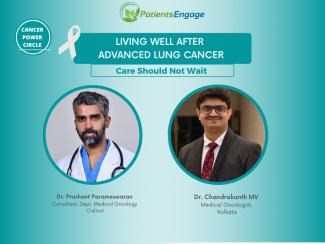
Internationally, lung cancer now causes 1.6 million deaths annually. It’s the most common cancer worldwide, and kills more people (27%) than any other cancer. Its death toll annually is greater than the total deaths caused by colon cancer, breast cancer and prostate cancer combined.
Among the top 10 leading causes of death worldwide, lung cancer is number five. Cardiovascular disease continues to be the number one killer, followed by stroke, chronic obstructive lung disease (a heavy risk factor for lung cancer itself), and lower respiratory infections.
While the five-year survival rate is 54 percent for cases detected, that’s only when the disease is localized within the lungs. Only 15 percent of lung cancer cases are diagnosed at that early a stage. The five-year survival rate drops to just 4% once the primary lung cancer has spread to other organs.
The Smoking Gun
The greatest negative force involved in lung cancer incidence is smoking. The American Lung Association estimates that active smoking is responsible for close to 90% of lung cancer cases. Other interrelated risk factors include exposures to radon, outdoor air pollution, asbestos, uranium, and radiation treatment to the chest (for diseases like breast cancer or lymphoma).
But while quitting smoking can decrease your lung cancer risk, it depends on your age, the number of years smoked before quitting, and how many cigarettes you smoked each day on average. As many as 20% of those who die of lung cancer annually never smoked or used tobacco.
More women die from lung cancer than breast cancer and ovarian cancer deaths combined. But in a survey conducted by the American Legacy Foundation, 80 percent of American women believe that breast cancer is the primary cause of cancer death among women. More worrisome is that experts predict a rising epidemic of female lung cancer. Incidence rates among women could quadruple by 2040 according to one source, for reasons including:
- Young women have started smoking at younger and younger ages.
- A women who smokes the same number of cigarettes as a man is twice as likely to develop lung cancer because men have a greater ability to detoxify toxins.
- Estrogen increases cancer incidence and growth.
A Silent Parade
With such an impact, why isn’t lung cancer getting the attention and funding it seems to deserve? Where are the huge fundraising walks, runs, nightly news stories, advocacy efforts, celebrity stories of hope and cause-related fundraising programs at every retail store counter?
Sadly, there is no “mass movement” because…
1) There are very few lung cancer survivors to lead activities, fundraising or large-scale advocacy.
2) About two out of three lung cancers are diagnosed in people over age 65, and the average age at diagnosis is 71. 6 So our small number of survivors are often too tired or in poor health, mentally and/or physically to lead the movement anyway. In comparison, 34% of all invasive breast cancer incidences occur in women under age 55, and 12% of those women are younger than age 45.
3) Lung cancer continues to have its usual stigma related to cigarette smoking. The “they got what was coming to them and should have known better” issue.
4) Nearly 80% of the more than 1 billion smokers worldwide live in low- and middle-income countries. At the local level, this relation to low income and limited education also exists. It means that a great percentage of smokers and eventual lung cancer patients are poor, have little education, money, power or influence.
In more everyday context, the tobacco industry itself had a value of over $40 billion last year internationally. Our international lung cancer commitment in the same period was 2% of that.
So Who Cares?
I join with others who believe it is past time to take lung cancer much more seriously. Not as a single nation, but as a world of intelligent people. Frankly the numbers speak for themselves.
Awareness campaigns are still needed. Organizational or small- to mid-size collaborative research projects are inspiring and helpful. But however “promising” and hope-filled they seem, they are inadequate to make the major impact needed.
I consider there to be three interwoven areas in this war:
- Catch lung cancer earlier while it is still treatable and either pre-cancerous or stage I lung cancer.
- Create better, less toxic, less invasive treatments that have longer efficacy.
- Prevent lung cancer from happening in the first place.
The good news is that we are doing well at the first two.
For the complete post, please read http://everyday2cents.blogspot.sg/
What’s Next?
Many people, including me, think that a durable nicotine vaccine of some kind is the logical choice to put our money on—not just to help people quit smoking, but to prevent anyone from ever getting addicted to smoking.
In the end, here’s the rub. Lung cancer is not an American problem. It is not a smoker’s problem. It is not a male problem or a female problem. And it is not the problem of the poor, rich or middle class. Lung cancer is everyone’s problem. Taking it on for good requires deeper international collaboration, corporate collaboration, government funding collaboration, and moral and ethical discussion, debates and fights.The question is, are we really interested in going there?
Statistics and sources consulted in preparing this blog included:
American Lung Association, American Cancer Society, World Health Organization, National Cancer Institute (NCI), Department of Defense (DoD), Centers for Disease Control and Prevention (CDC), Harvard School of Public Health, Cancer Treatment Centers of America, Research and Markets, IBIS World, New York Times, and many more.
Why I Care
Prior to forming DigitalHealthcom Group, I was a communications director at an NCI comprehensive cancer center for almost a decade and had the privilege of getting to know many lung cancer patients and their families. I shared their stories with others, including those who might choose to make financial gifts for research. I also watched far too many of them die too soon. A few years later, I then watched the same happen to a close family member. I’m interested in learning more, and somehow being part of progress. Or learning why it is not a priority, and what the other answer might be.
Guest post by John Senall, principal and founder of Mobile First Media and Digital Healthcom Group, who was a communications director at an NCI comprehensive cancer center for almost a decade and lost a close family member.
Original post at http://bit.ly/1NovOdk






